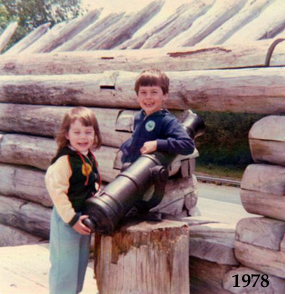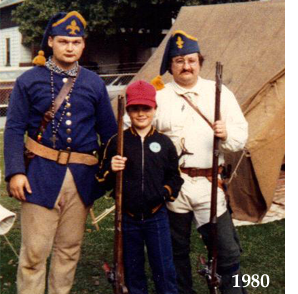 Whenever someone asks what sparked my interest in American history, I always give the same answer, my parents. Over the years I had some excellent teachers who cultivated my interest, but no one else promoted the subject more than my mom and dad. Looking back I fondly recall dozens of family trips to historical sites like Monticello, Gettysburg, Williamsburg and the Drake Oil Well. One of our favorite places, Fort Ligonier, wasn’t too far from our home in Pittsburgh. I remember traveling there on a number of occasions and credit that site in particular for my interest in 18th-century history.
Whenever someone asks what sparked my interest in American history, I always give the same answer, my parents. Over the years I had some excellent teachers who cultivated my interest, but no one else promoted the subject more than my mom and dad. Looking back I fondly recall dozens of family trips to historical sites like Monticello, Gettysburg, Williamsburg and the Drake Oil Well. One of our favorite places, Fort Ligonier, wasn’t too far from our home in Pittsburgh. I remember traveling there on a number of occasions and credit that site in particular for my interest in 18th-century history.
Unlike Fort Pitt, Fort Ligonier was completely reconstructed and therefore able to hold the attention of a hyper-active child like myself. I believe that my first exposure to re-enactors took place during “Ligonier Days” a three-day festival when living historians, dressed-up as British soldiers and Indians, demonstrated their weapons and tactics. The memory of that event is still very vivid as I was captivated by the experience.
Located in southwestern Pennsylvania, Fort Ligonier was constructed in 1758 for use as a British garrison. During its lifetime, the stronghold served multiple purposes including time as a port of passage for troops en route to Fort Pitt, and as a vital link for the British Army’s supply lines. A number of regulars were stationed there including the 60th Regiment of Foot (Royal Americans), the First Highland Battalion (Montgomery’s Highlanders), the 77th Regiment of Foot, a Royal Artillery detachment, the 94th Regiment of Foot (Royal Welsh Volunteers) and the 42nd Royal Highland Regiment of Foot (Black Watch). Fort Ligonier’s proximity to the French garrison at Fort Duquesne also made it a target.
 Originally referred to as “The Post at Loyalhanna,” Ligonier came under fire on October 12, 1758 during the French and Indian War. Still under construction, the garrison was barely able to repel its attackers who boasted much higher numbers. After decimating British troops who were stationed outside the walls, the French and Indians were driven back by artillery. As darkness fell the remaining forces renewed their attack before retreating back into the woods. The casualty reports following the four-hour assault differed greatly as the French reported taking 100 scalps and seven prisoners, while the British only reported 12 killed, 18 wounded, and 31 missing.
Originally referred to as “The Post at Loyalhanna,” Ligonier came under fire on October 12, 1758 during the French and Indian War. Still under construction, the garrison was barely able to repel its attackers who boasted much higher numbers. After decimating British troops who were stationed outside the walls, the French and Indians were driven back by artillery. As darkness fell the remaining forces renewed their attack before retreating back into the woods. The casualty reports following the four-hour assault differed greatly as the French reported taking 100 scalps and seven prisoners, while the British only reported 12 killed, 18 wounded, and 31 missing.
In November of that year General John Forbes assumed custody of the newly abandoned Fort Duquesne. He designated the site “Pittsburgh” to honor William Pitt, the acting Secretary of State. He then christened the fort known as Loyalhanna "Fort Ligonier," after his superior Sir John Ligonier, commander in chief in Great Britain.
During the Pontiac’s War of 1763, a coalition of Native American tribes attacked a number of forts in protest of British policies following the French and Indian War. Fort Ligonier was attacked twice and besieged by Indians who were eventually defeated at the Battle of Bushy Run. Three years later the fort, was decommissioned and handed over to a caretaker named Arthur St. Clair. In 1765, the Provost William Smith from the College of Philadelphia declared the importance of the site stating, “The preservation of Fort Ligonier was of the utmost consequence.”
Despite the absence of war the region around Fort Ligonier remained a dangerous one deep into the next decade. In November of 1777 a commissary named Samuel Craig Sr. was summoned to the garrison. While en route he was captured by Indians near an area called Chestnut Ridge. All efforts to locate the man failed, although his horse was found shot dead, surrounded by fragments of torn paper. Craig and his three eldest sons, John, Alexander and Samuel Jr., had served in the Revolutionary War prompting the belief that he had attempted to defend himself against hostiles.
Several acres of the garrison’s property were preserved and the above-ground elements were rebuilt. The inner-fort is 200 square-feet with four bastions, one on each corner. According to the site’s website the fort can be accessed by three gates where “…inside is the officers’ mess, barracks, quartermaster, guardroom, underground magazine, commissary, and officers’ quarters. Immediately outside the fort is General Forbes’s hut. An outer retrenchment, 1,600 feet long, surrounds the fort. Other external buildings include the Pennsylvania hospital (two wards and a surgeon’s hut), a smokehouse, a saw mill, bake ovens, a log dwelling and a forge.”
The transcripts of a journal detailing the fort's construction are available in the Report of the Commission to Locate the Site of the Frontier Forts of Pennsylvania. Volume Two, The Frontier Forts of Western Pennsylvania, Fort Ligonier by Clarence M. Busch, State Printer of Pennsylvania, 1896.
Today a museum compliments the fully-restored Fort Ligonier and features a collection of George Washington relics including his saddle pistols, an 11-page memoir on the French and Indian War and a Rembrandt Peale portrait. Washington had served there as a young colonel of the Virginia Regiment in service to the British Crown. A long-term installation titled “The World Ablaze: An Introduction to the Seven Years’ War” is on exhibit there. This unique collection features over 200 British, French and Native American items.
Not much has changed since I first visited Fort Ligonier as a kid. Each year thousands of tourists from all over the world travel to southwestern PA to experience life in the 1700’s. This includes busloads of children who flock to “Ligonier Days” just like I did. I have no doubt that there are plenty of future historians among them guaranteeing that the legacy of this historical gem will be preserved for generations to come. For more information or to plan your trip, visit the Fort Ligonier website.
Updated: Saturday, 26 March 2011 2:45 PM EDT
Permalink | Share This Post





